Business and the Business Environment Report - Tesco Analysis
VerifiedAdded on 2021/02/20
|12
|3596
|25
Report
AI Summary
This report provides a comprehensive analysis of the business and its environment, focusing on Tesco as a case study. It begins by explaining different types of organizations (public, private, and voluntary) and their purposes, legal structures, sizes, and scopes. The report then explores various organizational functions, including marketing, human resources, and finance, and how these functions contribute to the company's overall objectives. Furthermore, the report delves into the positive and negative impacts of the macro environment, utilizing PESTLE analysis to examine political, economic, social, and technological factors affecting Tesco. Finally, the report identifies and analyzes the internal and external factors that shape the strengths and weaknesses of the organization and how these interrelate with the external macro factors. The conclusion summarizes the key findings and insights gained throughout the analysis.
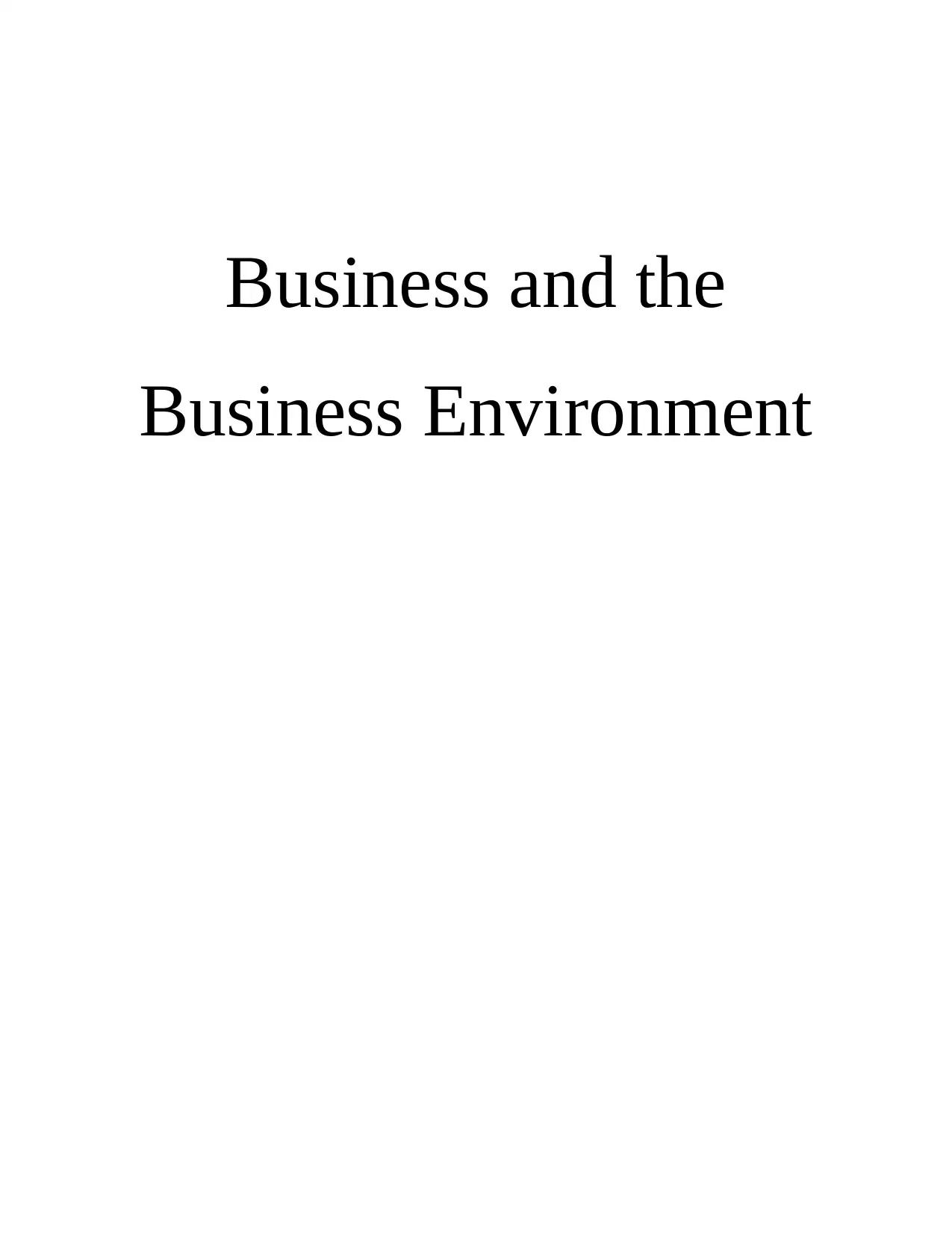
Business and the
Business Environment
Business Environment
Paraphrase This Document
Need a fresh take? Get an instant paraphrase of this document with our AI Paraphraser
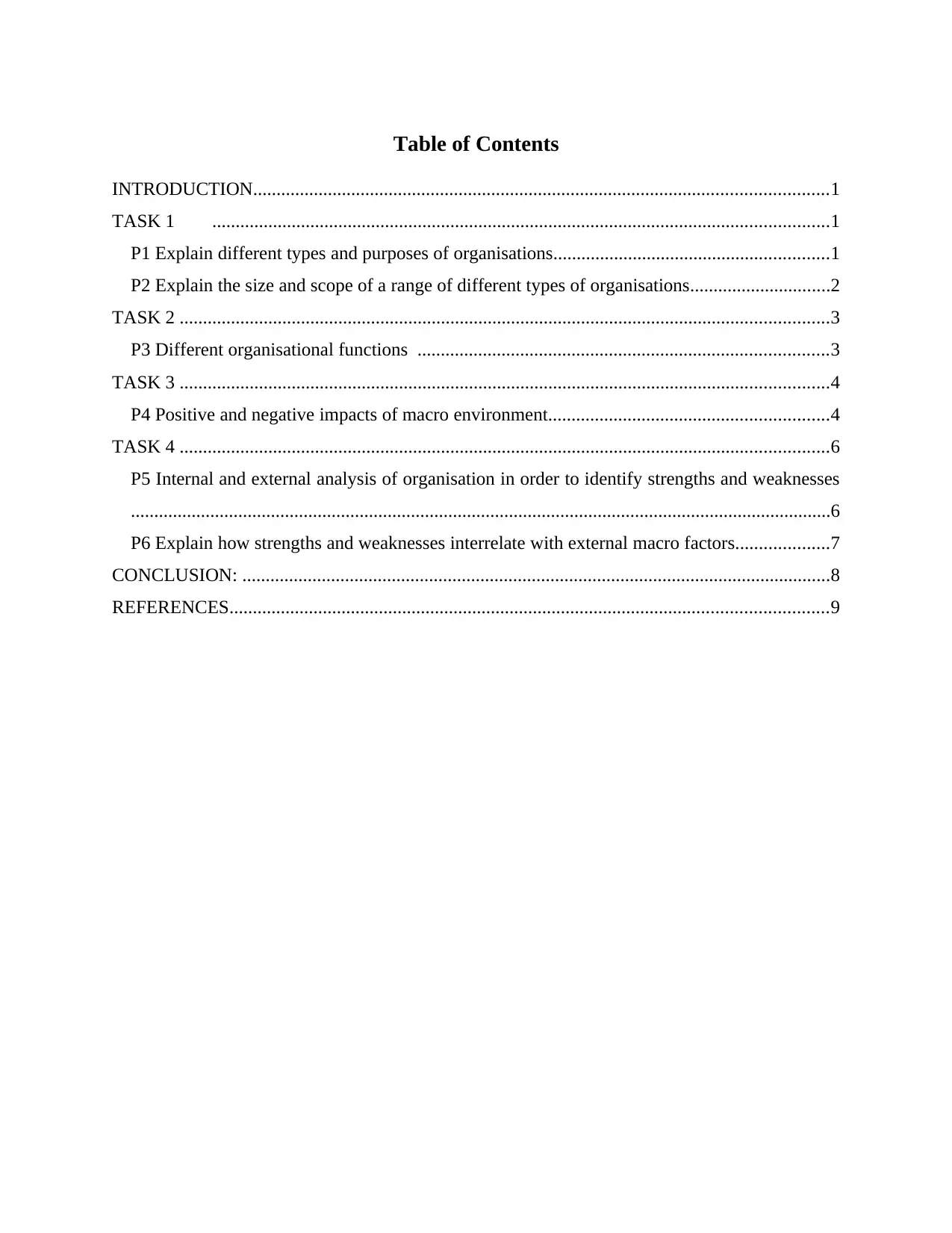
Table of Contents
INTRODUCTION...........................................................................................................................1
TASK 1 ....................................................................................................................................1
P1 Explain different types and purposes of organisations...........................................................1
P2 Explain the size and scope of a range of different types of organisations..............................2
TASK 2 ...........................................................................................................................................3
P3 Different organisational functions ........................................................................................3
TASK 3 ...........................................................................................................................................4
P4 Positive and negative impacts of macro environment............................................................4
TASK 4 ...........................................................................................................................................6
P5 Internal and external analysis of organisation in order to identify strengths and weaknesses
......................................................................................................................................................6
P6 Explain how strengths and weaknesses interrelate with external macro factors....................7
CONCLUSION: ..............................................................................................................................8
REFERENCES................................................................................................................................9
INTRODUCTION...........................................................................................................................1
TASK 1 ....................................................................................................................................1
P1 Explain different types and purposes of organisations...........................................................1
P2 Explain the size and scope of a range of different types of organisations..............................2
TASK 2 ...........................................................................................................................................3
P3 Different organisational functions ........................................................................................3
TASK 3 ...........................................................................................................................................4
P4 Positive and negative impacts of macro environment............................................................4
TASK 4 ...........................................................................................................................................6
P5 Internal and external analysis of organisation in order to identify strengths and weaknesses
......................................................................................................................................................6
P6 Explain how strengths and weaknesses interrelate with external macro factors....................7
CONCLUSION: ..............................................................................................................................8
REFERENCES................................................................................................................................9

⊘ This is a preview!⊘
Do you want full access?
Subscribe today to unlock all pages.

Trusted by 1+ million students worldwide
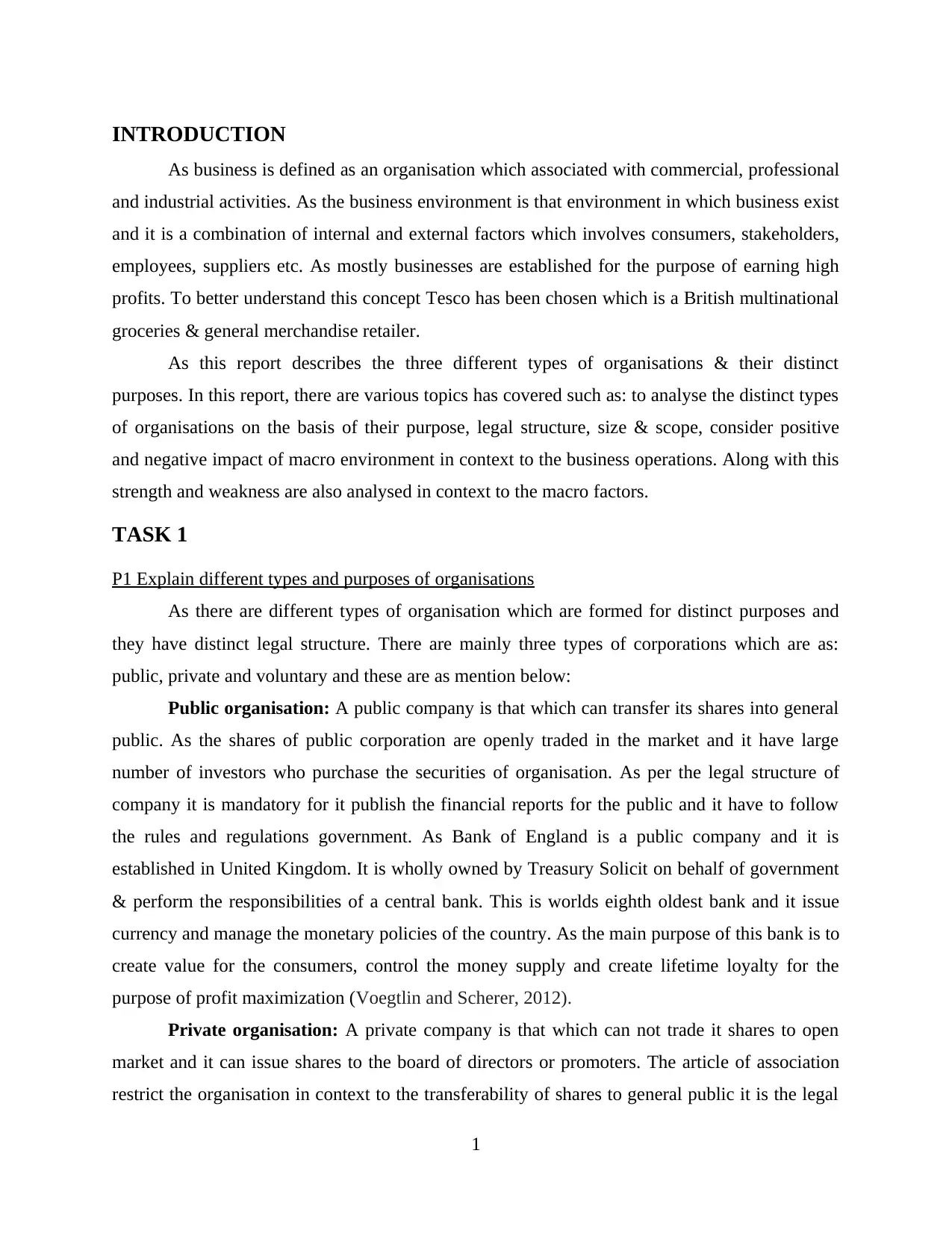
INTRODUCTION
As business is defined as an organisation which associated with commercial, professional
and industrial activities. As the business environment is that environment in which business exist
and it is a combination of internal and external factors which involves consumers, stakeholders,
employees, suppliers etc. As mostly businesses are established for the purpose of earning high
profits. To better understand this concept Tesco has been chosen which is a British multinational
groceries & general merchandise retailer.
As this report describes the three different types of organisations & their distinct
purposes. In this report, there are various topics has covered such as: to analyse the distinct types
of organisations on the basis of their purpose, legal structure, size & scope, consider positive
and negative impact of macro environment in context to the business operations. Along with this
strength and weakness are also analysed in context to the macro factors.
TASK 1
P1 Explain different types and purposes of organisations
As there are different types of organisation which are formed for distinct purposes and
they have distinct legal structure. There are mainly three types of corporations which are as:
public, private and voluntary and these are as mention below:
Public organisation: A public company is that which can transfer its shares into general
public. As the shares of public corporation are openly traded in the market and it have large
number of investors who purchase the securities of organisation. As per the legal structure of
company it is mandatory for it publish the financial reports for the public and it have to follow
the rules and regulations government. As Bank of England is a public company and it is
established in United Kingdom. It is wholly owned by Treasury Solicit on behalf of government
& perform the responsibilities of a central bank. This is worlds eighth oldest bank and it issue
currency and manage the monetary policies of the country. As the main purpose of this bank is to
create value for the consumers, control the money supply and create lifetime loyalty for the
purpose of profit maximization (Voegtlin and Scherer, 2012).
Private organisation: A private company is that which can not trade it shares to open
market and it can issue shares to the board of directors or promoters. The article of association
restrict the organisation in context to the transferability of shares to general public it is the legal
1
As business is defined as an organisation which associated with commercial, professional
and industrial activities. As the business environment is that environment in which business exist
and it is a combination of internal and external factors which involves consumers, stakeholders,
employees, suppliers etc. As mostly businesses are established for the purpose of earning high
profits. To better understand this concept Tesco has been chosen which is a British multinational
groceries & general merchandise retailer.
As this report describes the three different types of organisations & their distinct
purposes. In this report, there are various topics has covered such as: to analyse the distinct types
of organisations on the basis of their purpose, legal structure, size & scope, consider positive
and negative impact of macro environment in context to the business operations. Along with this
strength and weakness are also analysed in context to the macro factors.
TASK 1
P1 Explain different types and purposes of organisations
As there are different types of organisation which are formed for distinct purposes and
they have distinct legal structure. There are mainly three types of corporations which are as:
public, private and voluntary and these are as mention below:
Public organisation: A public company is that which can transfer its shares into general
public. As the shares of public corporation are openly traded in the market and it have large
number of investors who purchase the securities of organisation. As per the legal structure of
company it is mandatory for it publish the financial reports for the public and it have to follow
the rules and regulations government. As Bank of England is a public company and it is
established in United Kingdom. It is wholly owned by Treasury Solicit on behalf of government
& perform the responsibilities of a central bank. This is worlds eighth oldest bank and it issue
currency and manage the monetary policies of the country. As the main purpose of this bank is to
create value for the consumers, control the money supply and create lifetime loyalty for the
purpose of profit maximization (Voegtlin and Scherer, 2012).
Private organisation: A private company is that which can not trade it shares to open
market and it can issue shares to the board of directors or promoters. The article of association
restrict the organisation in context to the transferability of shares to general public it is the legal
1
Paraphrase This Document
Need a fresh take? Get an instant paraphrase of this document with our AI Paraphraser
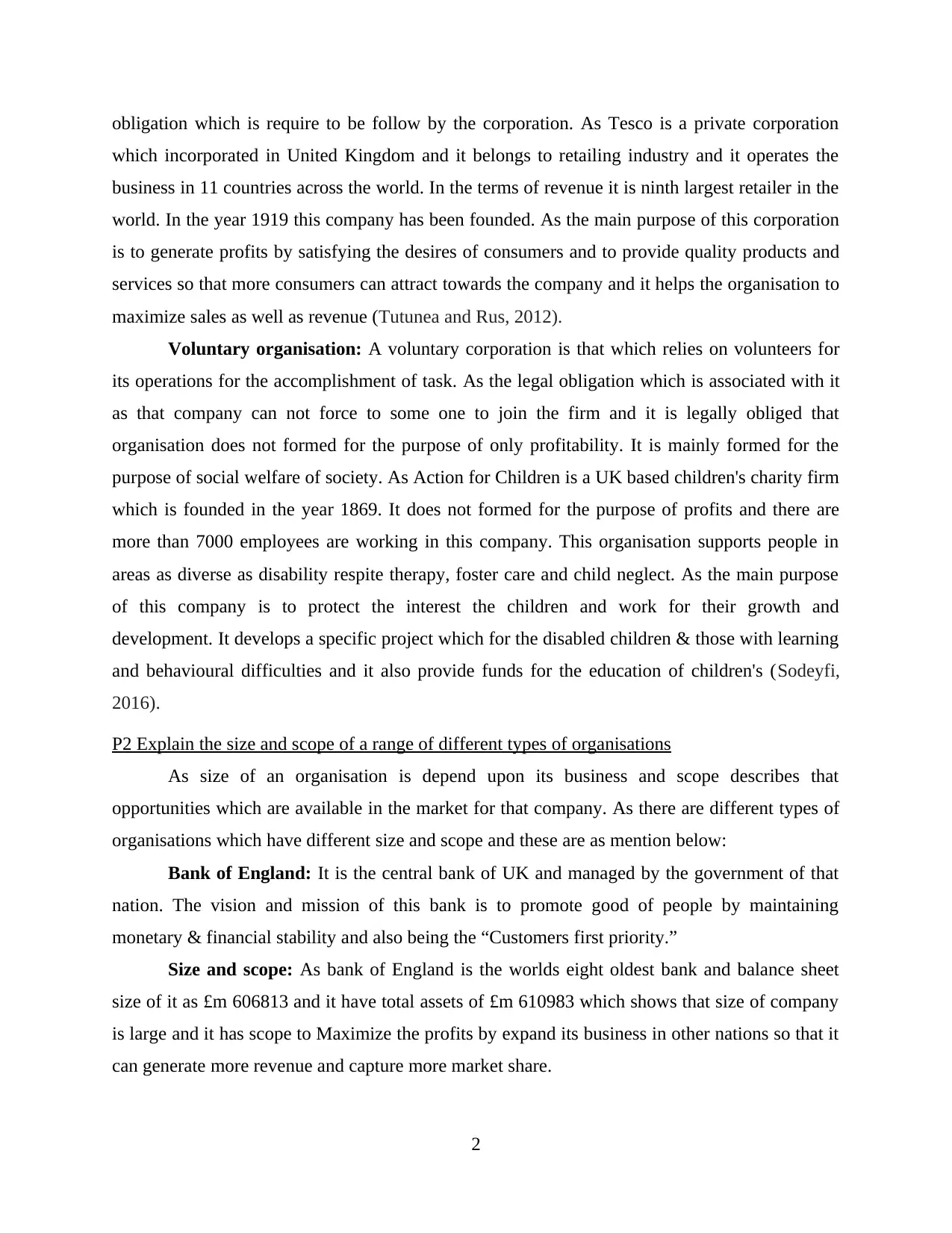
obligation which is require to be follow by the corporation. As Tesco is a private corporation
which incorporated in United Kingdom and it belongs to retailing industry and it operates the
business in 11 countries across the world. In the terms of revenue it is ninth largest retailer in the
world. In the year 1919 this company has been founded. As the main purpose of this corporation
is to generate profits by satisfying the desires of consumers and to provide quality products and
services so that more consumers can attract towards the company and it helps the organisation to
maximize sales as well as revenue (Tutunea and Rus, 2012).
Voluntary organisation: A voluntary corporation is that which relies on volunteers for
its operations for the accomplishment of task. As the legal obligation which is associated with it
as that company can not force to some one to join the firm and it is legally obliged that
organisation does not formed for the purpose of only profitability. It is mainly formed for the
purpose of social welfare of society. As Action for Children is a UK based children's charity firm
which is founded in the year 1869. It does not formed for the purpose of profits and there are
more than 7000 employees are working in this company. This organisation supports people in
areas as diverse as disability respite therapy, foster care and child neglect. As the main purpose
of this company is to protect the interest the children and work for their growth and
development. It develops a specific project which for the disabled children & those with learning
and behavioural difficulties and it also provide funds for the education of children's (Sodeyfi,
2016).
P2 Explain the size and scope of a range of different types of organisations
As size of an organisation is depend upon its business and scope describes that
opportunities which are available in the market for that company. As there are different types of
organisations which have different size and scope and these are as mention below:
Bank of England: It is the central bank of UK and managed by the government of that
nation. The vision and mission of this bank is to promote good of people by maintaining
monetary & financial stability and also being the “Customers first priority.”
Size and scope: As bank of England is the worlds eight oldest bank and balance sheet
size of it as £m 606813 and it have total assets of £m 610983 which shows that size of company
is large and it has scope to Maximize the profits by expand its business in other nations so that it
can generate more revenue and capture more market share.
2
which incorporated in United Kingdom and it belongs to retailing industry and it operates the
business in 11 countries across the world. In the terms of revenue it is ninth largest retailer in the
world. In the year 1919 this company has been founded. As the main purpose of this corporation
is to generate profits by satisfying the desires of consumers and to provide quality products and
services so that more consumers can attract towards the company and it helps the organisation to
maximize sales as well as revenue (Tutunea and Rus, 2012).
Voluntary organisation: A voluntary corporation is that which relies on volunteers for
its operations for the accomplishment of task. As the legal obligation which is associated with it
as that company can not force to some one to join the firm and it is legally obliged that
organisation does not formed for the purpose of only profitability. It is mainly formed for the
purpose of social welfare of society. As Action for Children is a UK based children's charity firm
which is founded in the year 1869. It does not formed for the purpose of profits and there are
more than 7000 employees are working in this company. This organisation supports people in
areas as diverse as disability respite therapy, foster care and child neglect. As the main purpose
of this company is to protect the interest the children and work for their growth and
development. It develops a specific project which for the disabled children & those with learning
and behavioural difficulties and it also provide funds for the education of children's (Sodeyfi,
2016).
P2 Explain the size and scope of a range of different types of organisations
As size of an organisation is depend upon its business and scope describes that
opportunities which are available in the market for that company. As there are different types of
organisations which have different size and scope and these are as mention below:
Bank of England: It is the central bank of UK and managed by the government of that
nation. The vision and mission of this bank is to promote good of people by maintaining
monetary & financial stability and also being the “Customers first priority.”
Size and scope: As bank of England is the worlds eight oldest bank and balance sheet
size of it as £m 606813 and it have total assets of £m 610983 which shows that size of company
is large and it has scope to Maximize the profits by expand its business in other nations so that it
can generate more revenue and capture more market share.
2
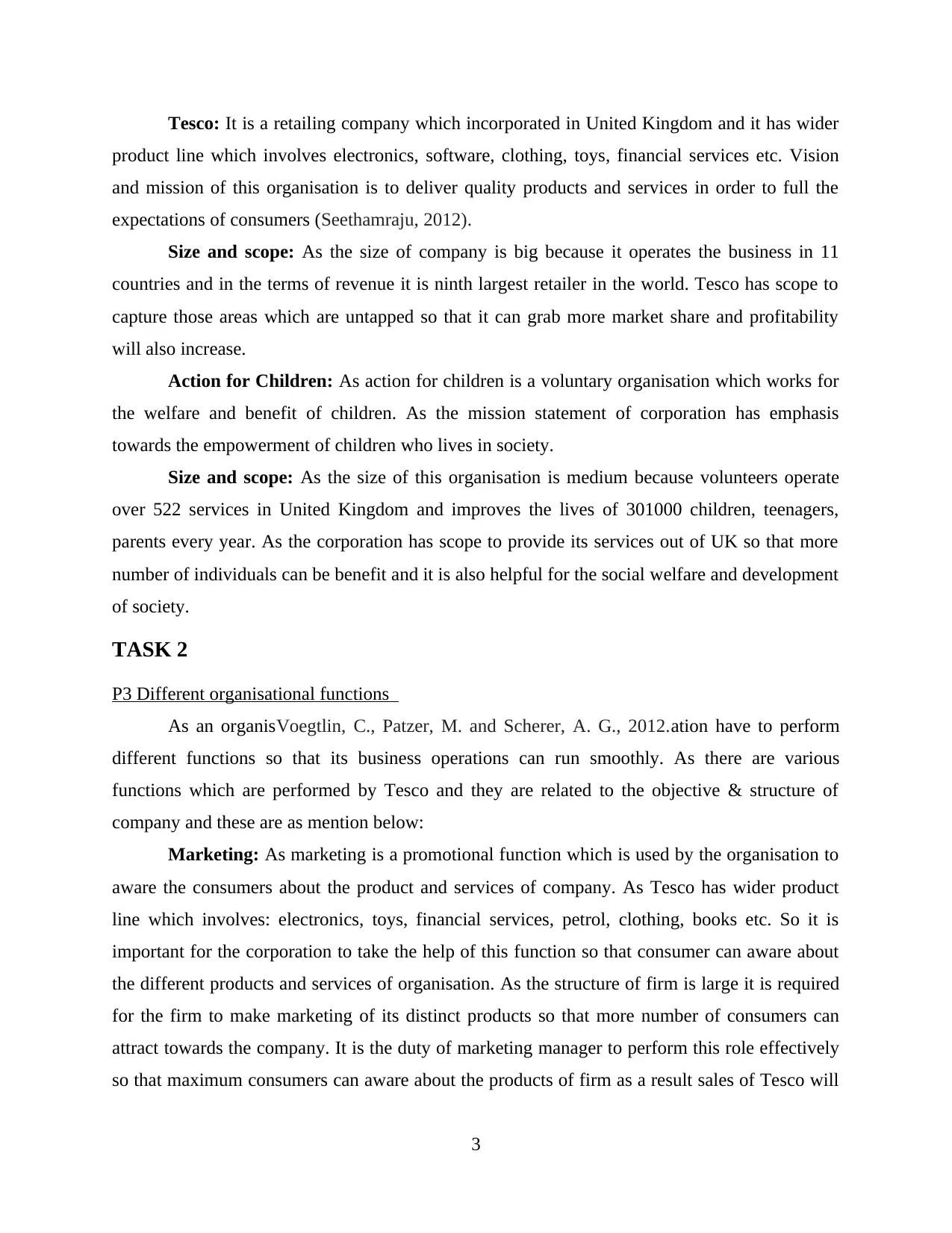
Tesco: It is a retailing company which incorporated in United Kingdom and it has wider
product line which involves electronics, software, clothing, toys, financial services etc. Vision
and mission of this organisation is to deliver quality products and services in order to full the
expectations of consumers (Seethamraju, 2012).
Size and scope: As the size of company is big because it operates the business in 11
countries and in the terms of revenue it is ninth largest retailer in the world. Tesco has scope to
capture those areas which are untapped so that it can grab more market share and profitability
will also increase.
Action for Children: As action for children is a voluntary organisation which works for
the welfare and benefit of children. As the mission statement of corporation has emphasis
towards the empowerment of children who lives in society.
Size and scope: As the size of this organisation is medium because volunteers operate
over 522 services in United Kingdom and improves the lives of 301000 children, teenagers,
parents every year. As the corporation has scope to provide its services out of UK so that more
number of individuals can be benefit and it is also helpful for the social welfare and development
of society.
TASK 2
P3 Different organisational functions
As an organisVoegtlin, C., Patzer, M. and Scherer, A. G., 2012.ation have to perform
different functions so that its business operations can run smoothly. As there are various
functions which are performed by Tesco and they are related to the objective & structure of
company and these are as mention below:
Marketing: As marketing is a promotional function which is used by the organisation to
aware the consumers about the product and services of company. As Tesco has wider product
line which involves: electronics, toys, financial services, petrol, clothing, books etc. So it is
important for the corporation to take the help of this function so that consumer can aware about
the different products and services of organisation. As the structure of firm is large it is required
for the firm to make marketing of its distinct products so that more number of consumers can
attract towards the company. It is the duty of marketing manager to perform this role effectively
so that maximum consumers can aware about the products of firm as a result sales of Tesco will
3
product line which involves electronics, software, clothing, toys, financial services etc. Vision
and mission of this organisation is to deliver quality products and services in order to full the
expectations of consumers (Seethamraju, 2012).
Size and scope: As the size of company is big because it operates the business in 11
countries and in the terms of revenue it is ninth largest retailer in the world. Tesco has scope to
capture those areas which are untapped so that it can grab more market share and profitability
will also increase.
Action for Children: As action for children is a voluntary organisation which works for
the welfare and benefit of children. As the mission statement of corporation has emphasis
towards the empowerment of children who lives in society.
Size and scope: As the size of this organisation is medium because volunteers operate
over 522 services in United Kingdom and improves the lives of 301000 children, teenagers,
parents every year. As the corporation has scope to provide its services out of UK so that more
number of individuals can be benefit and it is also helpful for the social welfare and development
of society.
TASK 2
P3 Different organisational functions
As an organisVoegtlin, C., Patzer, M. and Scherer, A. G., 2012.ation have to perform
different functions so that its business operations can run smoothly. As there are various
functions which are performed by Tesco and they are related to the objective & structure of
company and these are as mention below:
Marketing: As marketing is a promotional function which is used by the organisation to
aware the consumers about the product and services of company. As Tesco has wider product
line which involves: electronics, toys, financial services, petrol, clothing, books etc. So it is
important for the corporation to take the help of this function so that consumer can aware about
the different products and services of organisation. As the structure of firm is large it is required
for the firm to make marketing of its distinct products so that more number of consumers can
attract towards the company. It is the duty of marketing manager to perform this role effectively
so that maximum consumers can aware about the products of firm as a result sales of Tesco will
3
⊘ This is a preview!⊘
Do you want full access?
Subscribe today to unlock all pages.

Trusted by 1+ million students worldwide
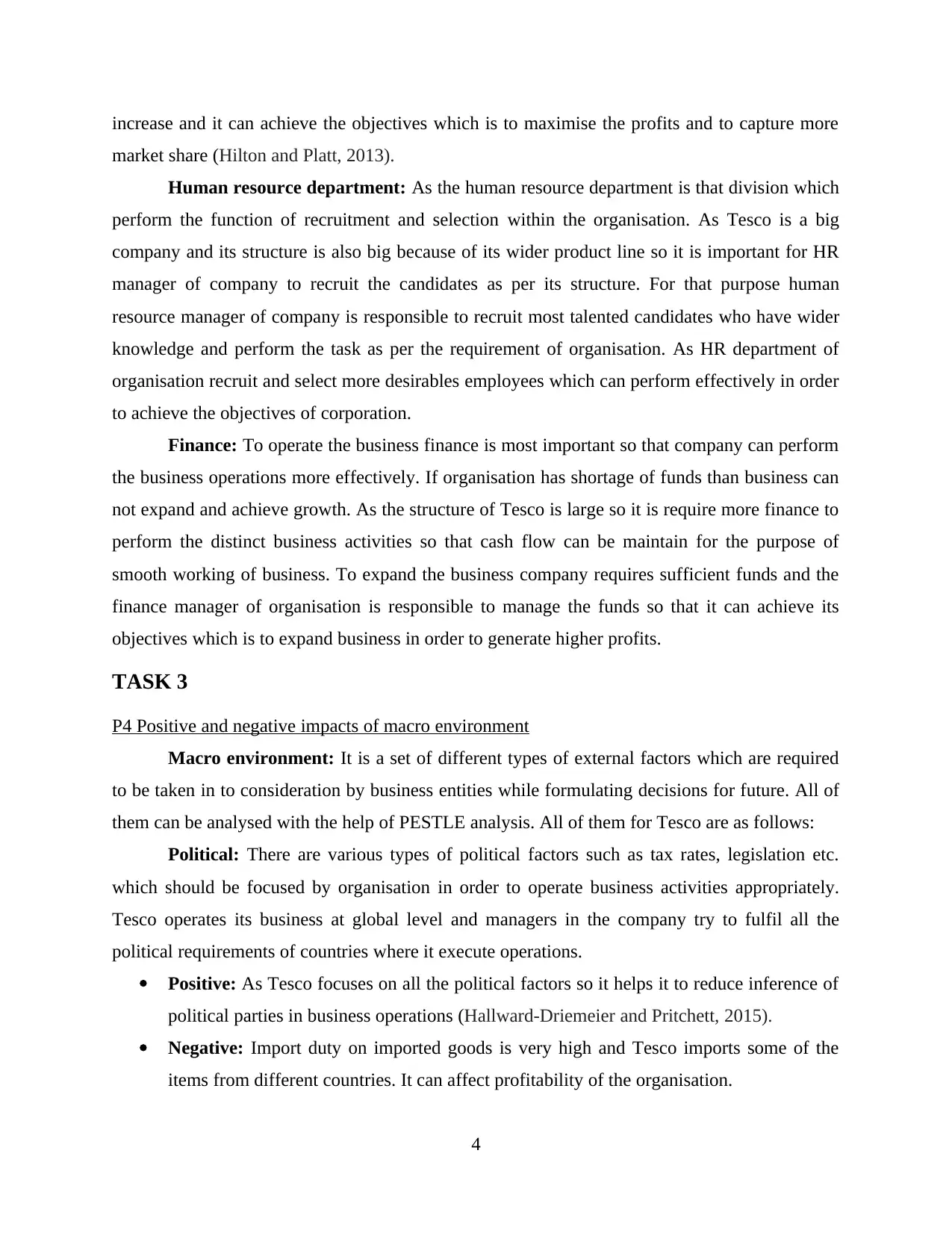
increase and it can achieve the objectives which is to maximise the profits and to capture more
market share (Hilton and Platt, 2013).
Human resource department: As the human resource department is that division which
perform the function of recruitment and selection within the organisation. As Tesco is a big
company and its structure is also big because of its wider product line so it is important for HR
manager of company to recruit the candidates as per its structure. For that purpose human
resource manager of company is responsible to recruit most talented candidates who have wider
knowledge and perform the task as per the requirement of organisation. As HR department of
organisation recruit and select more desirables employees which can perform effectively in order
to achieve the objectives of corporation.
Finance: To operate the business finance is most important so that company can perform
the business operations more effectively. If organisation has shortage of funds than business can
not expand and achieve growth. As the structure of Tesco is large so it is require more finance to
perform the distinct business activities so that cash flow can be maintain for the purpose of
smooth working of business. To expand the business company requires sufficient funds and the
finance manager of organisation is responsible to manage the funds so that it can achieve its
objectives which is to expand business in order to generate higher profits.
TASK 3
P4 Positive and negative impacts of macro environment
Macro environment: It is a set of different types of external factors which are required
to be taken in to consideration by business entities while formulating decisions for future. All of
them can be analysed with the help of PESTLE analysis. All of them for Tesco are as follows:
Political: There are various types of political factors such as tax rates, legislation etc.
which should be focused by organisation in order to operate business activities appropriately.
Tesco operates its business at global level and managers in the company try to fulfil all the
political requirements of countries where it execute operations.
Positive: As Tesco focuses on all the political factors so it helps it to reduce inference of
political parties in business operations (Hallward-Driemeier and Pritchett, 2015).
Negative: Import duty on imported goods is very high and Tesco imports some of the
items from different countries. It can affect profitability of the organisation.
4
market share (Hilton and Platt, 2013).
Human resource department: As the human resource department is that division which
perform the function of recruitment and selection within the organisation. As Tesco is a big
company and its structure is also big because of its wider product line so it is important for HR
manager of company to recruit the candidates as per its structure. For that purpose human
resource manager of company is responsible to recruit most talented candidates who have wider
knowledge and perform the task as per the requirement of organisation. As HR department of
organisation recruit and select more desirables employees which can perform effectively in order
to achieve the objectives of corporation.
Finance: To operate the business finance is most important so that company can perform
the business operations more effectively. If organisation has shortage of funds than business can
not expand and achieve growth. As the structure of Tesco is large so it is require more finance to
perform the distinct business activities so that cash flow can be maintain for the purpose of
smooth working of business. To expand the business company requires sufficient funds and the
finance manager of organisation is responsible to manage the funds so that it can achieve its
objectives which is to expand business in order to generate higher profits.
TASK 3
P4 Positive and negative impacts of macro environment
Macro environment: It is a set of different types of external factors which are required
to be taken in to consideration by business entities while formulating decisions for future. All of
them can be analysed with the help of PESTLE analysis. All of them for Tesco are as follows:
Political: There are various types of political factors such as tax rates, legislation etc.
which should be focused by organisation in order to operate business activities appropriately.
Tesco operates its business at global level and managers in the company try to fulfil all the
political requirements of countries where it execute operations.
Positive: As Tesco focuses on all the political factors so it helps it to reduce inference of
political parties in business operations (Hallward-Driemeier and Pritchett, 2015).
Negative: Import duty on imported goods is very high and Tesco imports some of the
items from different countries. It can affect profitability of the organisation.
4
Paraphrase This Document
Need a fresh take? Get an instant paraphrase of this document with our AI Paraphraser
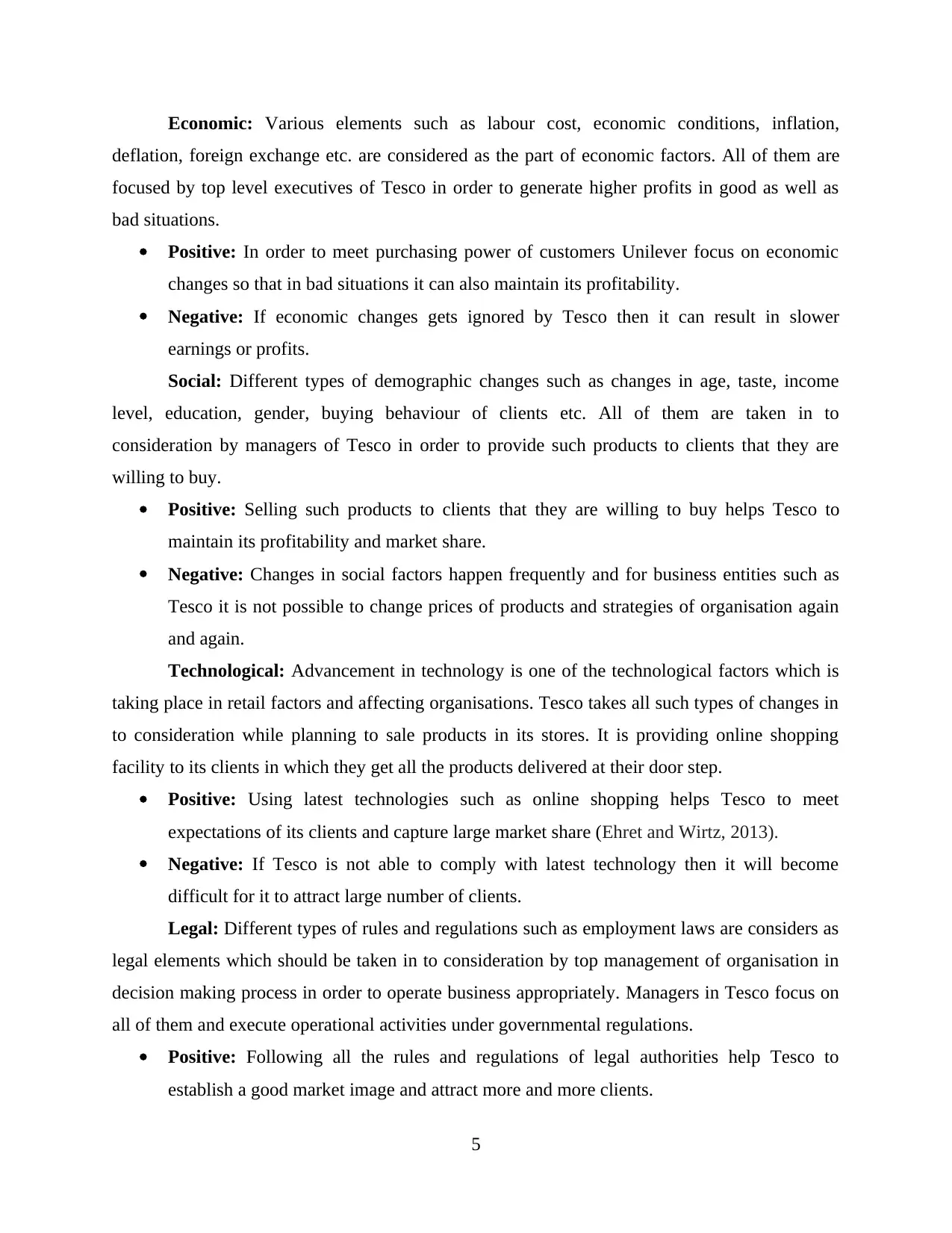
Economic: Various elements such as labour cost, economic conditions, inflation,
deflation, foreign exchange etc. are considered as the part of economic factors. All of them are
focused by top level executives of Tesco in order to generate higher profits in good as well as
bad situations.
Positive: In order to meet purchasing power of customers Unilever focus on economic
changes so that in bad situations it can also maintain its profitability.
Negative: If economic changes gets ignored by Tesco then it can result in slower
earnings or profits.
Social: Different types of demographic changes such as changes in age, taste, income
level, education, gender, buying behaviour of clients etc. All of them are taken in to
consideration by managers of Tesco in order to provide such products to clients that they are
willing to buy.
Positive: Selling such products to clients that they are willing to buy helps Tesco to
maintain its profitability and market share.
Negative: Changes in social factors happen frequently and for business entities such as
Tesco it is not possible to change prices of products and strategies of organisation again
and again.
Technological: Advancement in technology is one of the technological factors which is
taking place in retail factors and affecting organisations. Tesco takes all such types of changes in
to consideration while planning to sale products in its stores. It is providing online shopping
facility to its clients in which they get all the products delivered at their door step.
Positive: Using latest technologies such as online shopping helps Tesco to meet
expectations of its clients and capture large market share (Ehret and Wirtz, 2013).
Negative: If Tesco is not able to comply with latest technology then it will become
difficult for it to attract large number of clients.
Legal: Different types of rules and regulations such as employment laws are considers as
legal elements which should be taken in to consideration by top management of organisation in
decision making process in order to operate business appropriately. Managers in Tesco focus on
all of them and execute operational activities under governmental regulations.
Positive: Following all the rules and regulations of legal authorities help Tesco to
establish a good market image and attract more and more clients.
5
deflation, foreign exchange etc. are considered as the part of economic factors. All of them are
focused by top level executives of Tesco in order to generate higher profits in good as well as
bad situations.
Positive: In order to meet purchasing power of customers Unilever focus on economic
changes so that in bad situations it can also maintain its profitability.
Negative: If economic changes gets ignored by Tesco then it can result in slower
earnings or profits.
Social: Different types of demographic changes such as changes in age, taste, income
level, education, gender, buying behaviour of clients etc. All of them are taken in to
consideration by managers of Tesco in order to provide such products to clients that they are
willing to buy.
Positive: Selling such products to clients that they are willing to buy helps Tesco to
maintain its profitability and market share.
Negative: Changes in social factors happen frequently and for business entities such as
Tesco it is not possible to change prices of products and strategies of organisation again
and again.
Technological: Advancement in technology is one of the technological factors which is
taking place in retail factors and affecting organisations. Tesco takes all such types of changes in
to consideration while planning to sale products in its stores. It is providing online shopping
facility to its clients in which they get all the products delivered at their door step.
Positive: Using latest technologies such as online shopping helps Tesco to meet
expectations of its clients and capture large market share (Ehret and Wirtz, 2013).
Negative: If Tesco is not able to comply with latest technology then it will become
difficult for it to attract large number of clients.
Legal: Different types of rules and regulations such as employment laws are considers as
legal elements which should be taken in to consideration by top management of organisation in
decision making process in order to operate business appropriately. Managers in Tesco focus on
all of them and execute operational activities under governmental regulations.
Positive: Following all the rules and regulations of legal authorities help Tesco to
establish a good market image and attract more and more clients.
5
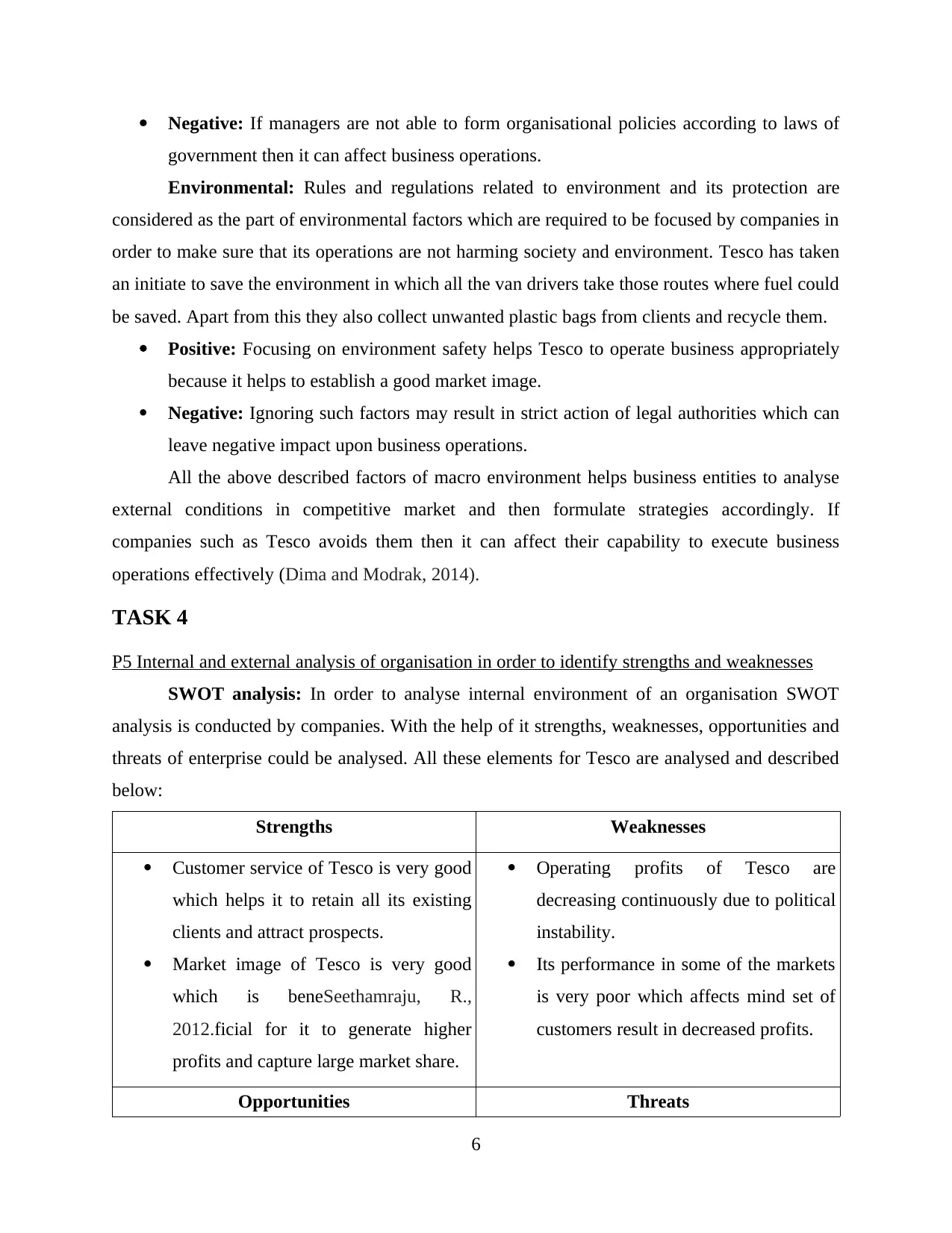
Negative: If managers are not able to form organisational policies according to laws of
government then it can affect business operations.
Environmental: Rules and regulations related to environment and its protection are
considered as the part of environmental factors which are required to be focused by companies in
order to make sure that its operations are not harming society and environment. Tesco has taken
an initiate to save the environment in which all the van drivers take those routes where fuel could
be saved. Apart from this they also collect unwanted plastic bags from clients and recycle them.
Positive: Focusing on environment safety helps Tesco to operate business appropriately
because it helps to establish a good market image.
Negative: Ignoring such factors may result in strict action of legal authorities which can
leave negative impact upon business operations.
All the above described factors of macro environment helps business entities to analyse
external conditions in competitive market and then formulate strategies accordingly. If
companies such as Tesco avoids them then it can affect their capability to execute business
operations effectively (Dima and Modrak, 2014).
TASK 4
P5 Internal and external analysis of organisation in order to identify strengths and weaknesses
SWOT analysis: In order to analyse internal environment of an organisation SWOT
analysis is conducted by companies. With the help of it strengths, weaknesses, opportunities and
threats of enterprise could be analysed. All these elements for Tesco are analysed and described
below:
Strengths Weaknesses
Customer service of Tesco is very good
which helps it to retain all its existing
clients and attract prospects.
Market image of Tesco is very good
which is beneSeethamraju, R.,
2012.ficial for it to generate higher
profits and capture large market share.
Operating profits of Tesco are
decreasing continuously due to political
instability.
Its performance in some of the markets
is very poor which affects mind set of
customers result in decreased profits.
Opportunities Threats
6
government then it can affect business operations.
Environmental: Rules and regulations related to environment and its protection are
considered as the part of environmental factors which are required to be focused by companies in
order to make sure that its operations are not harming society and environment. Tesco has taken
an initiate to save the environment in which all the van drivers take those routes where fuel could
be saved. Apart from this they also collect unwanted plastic bags from clients and recycle them.
Positive: Focusing on environment safety helps Tesco to operate business appropriately
because it helps to establish a good market image.
Negative: Ignoring such factors may result in strict action of legal authorities which can
leave negative impact upon business operations.
All the above described factors of macro environment helps business entities to analyse
external conditions in competitive market and then formulate strategies accordingly. If
companies such as Tesco avoids them then it can affect their capability to execute business
operations effectively (Dima and Modrak, 2014).
TASK 4
P5 Internal and external analysis of organisation in order to identify strengths and weaknesses
SWOT analysis: In order to analyse internal environment of an organisation SWOT
analysis is conducted by companies. With the help of it strengths, weaknesses, opportunities and
threats of enterprise could be analysed. All these elements for Tesco are analysed and described
below:
Strengths Weaknesses
Customer service of Tesco is very good
which helps it to retain all its existing
clients and attract prospects.
Market image of Tesco is very good
which is beneSeethamraju, R.,
2012.ficial for it to generate higher
profits and capture large market share.
Operating profits of Tesco are
decreasing continuously due to political
instability.
Its performance in some of the markets
is very poor which affects mind set of
customers result in decreased profits.
Opportunities Threats
6
⊘ This is a preview!⊘
Do you want full access?
Subscribe today to unlock all pages.

Trusted by 1+ million students worldwide
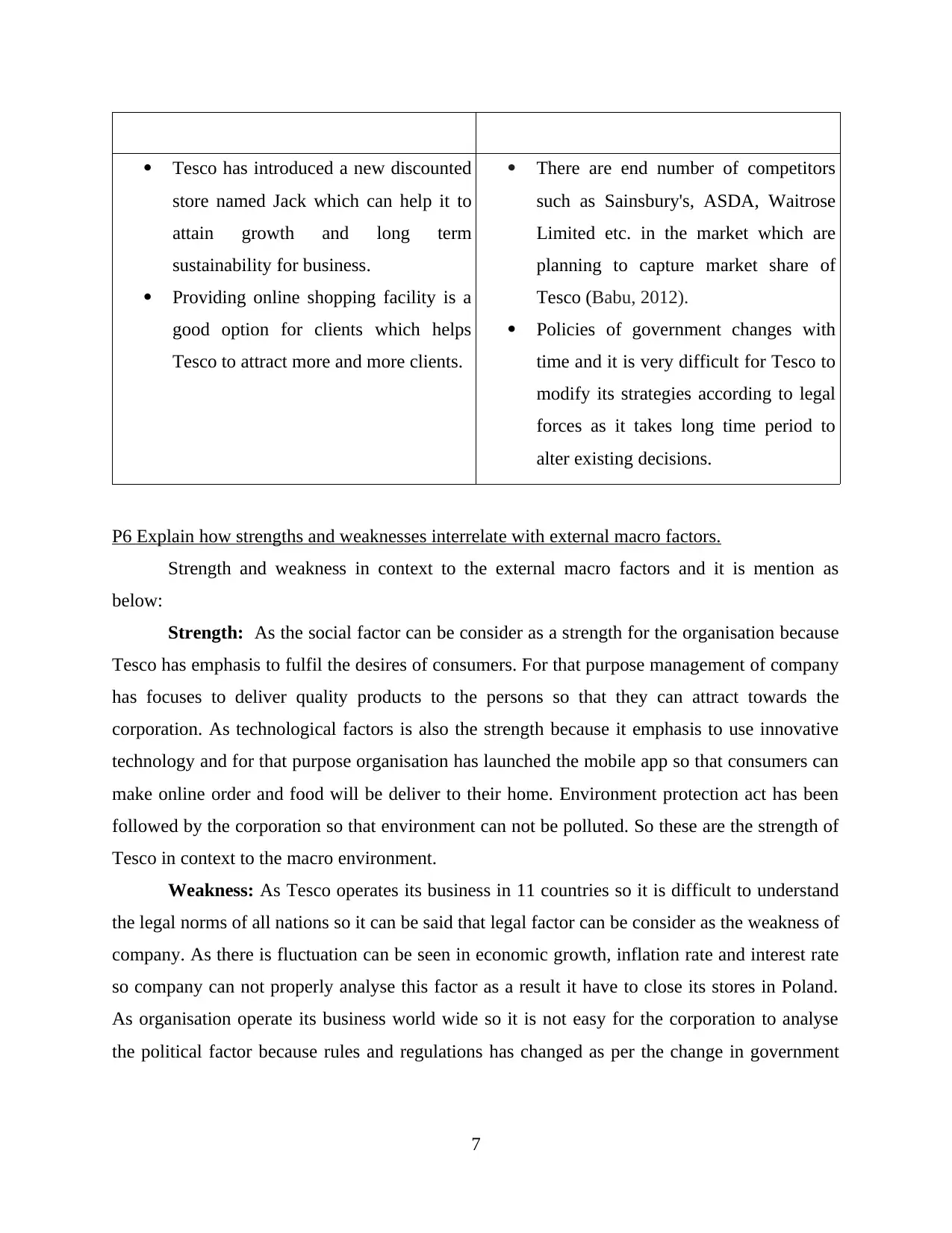
Tesco has introduced a new discounted
store named Jack which can help it to
attain growth and long term
sustainability for business.
Providing online shopping facility is a
good option for clients which helps
Tesco to attract more and more clients.
There are end number of competitors
such as Sainsbury's, ASDA, Waitrose
Limited etc. in the market which are
planning to capture market share of
Tesco (Babu, 2012).
Policies of government changes with
time and it is very difficult for Tesco to
modify its strategies according to legal
forces as it takes long time period to
alter existing decisions.
P6 Explain how strengths and weaknesses interrelate with external macro factors.
Strength and weakness in context to the external macro factors and it is mention as
below:
Strength: As the social factor can be consider as a strength for the organisation because
Tesco has emphasis to fulfil the desires of consumers. For that purpose management of company
has focuses to deliver quality products to the persons so that they can attract towards the
corporation. As technological factors is also the strength because it emphasis to use innovative
technology and for that purpose organisation has launched the mobile app so that consumers can
make online order and food will be deliver to their home. Environment protection act has been
followed by the corporation so that environment can not be polluted. So these are the strength of
Tesco in context to the macro environment.
Weakness: As Tesco operates its business in 11 countries so it is difficult to understand
the legal norms of all nations so it can be said that legal factor can be consider as the weakness of
company. As there is fluctuation can be seen in economic growth, inflation rate and interest rate
so company can not properly analyse this factor as a result it have to close its stores in Poland.
As organisation operate its business world wide so it is not easy for the corporation to analyse
the political factor because rules and regulations has changed as per the change in government
7
store named Jack which can help it to
attain growth and long term
sustainability for business.
Providing online shopping facility is a
good option for clients which helps
Tesco to attract more and more clients.
There are end number of competitors
such as Sainsbury's, ASDA, Waitrose
Limited etc. in the market which are
planning to capture market share of
Tesco (Babu, 2012).
Policies of government changes with
time and it is very difficult for Tesco to
modify its strategies according to legal
forces as it takes long time period to
alter existing decisions.
P6 Explain how strengths and weaknesses interrelate with external macro factors.
Strength and weakness in context to the external macro factors and it is mention as
below:
Strength: As the social factor can be consider as a strength for the organisation because
Tesco has emphasis to fulfil the desires of consumers. For that purpose management of company
has focuses to deliver quality products to the persons so that they can attract towards the
corporation. As technological factors is also the strength because it emphasis to use innovative
technology and for that purpose organisation has launched the mobile app so that consumers can
make online order and food will be deliver to their home. Environment protection act has been
followed by the corporation so that environment can not be polluted. So these are the strength of
Tesco in context to the macro environment.
Weakness: As Tesco operates its business in 11 countries so it is difficult to understand
the legal norms of all nations so it can be said that legal factor can be consider as the weakness of
company. As there is fluctuation can be seen in economic growth, inflation rate and interest rate
so company can not properly analyse this factor as a result it have to close its stores in Poland.
As organisation operate its business world wide so it is not easy for the corporation to analyse
the political factor because rules and regulations has changed as per the change in government
7
Paraphrase This Document
Need a fresh take? Get an instant paraphrase of this document with our AI Paraphraser
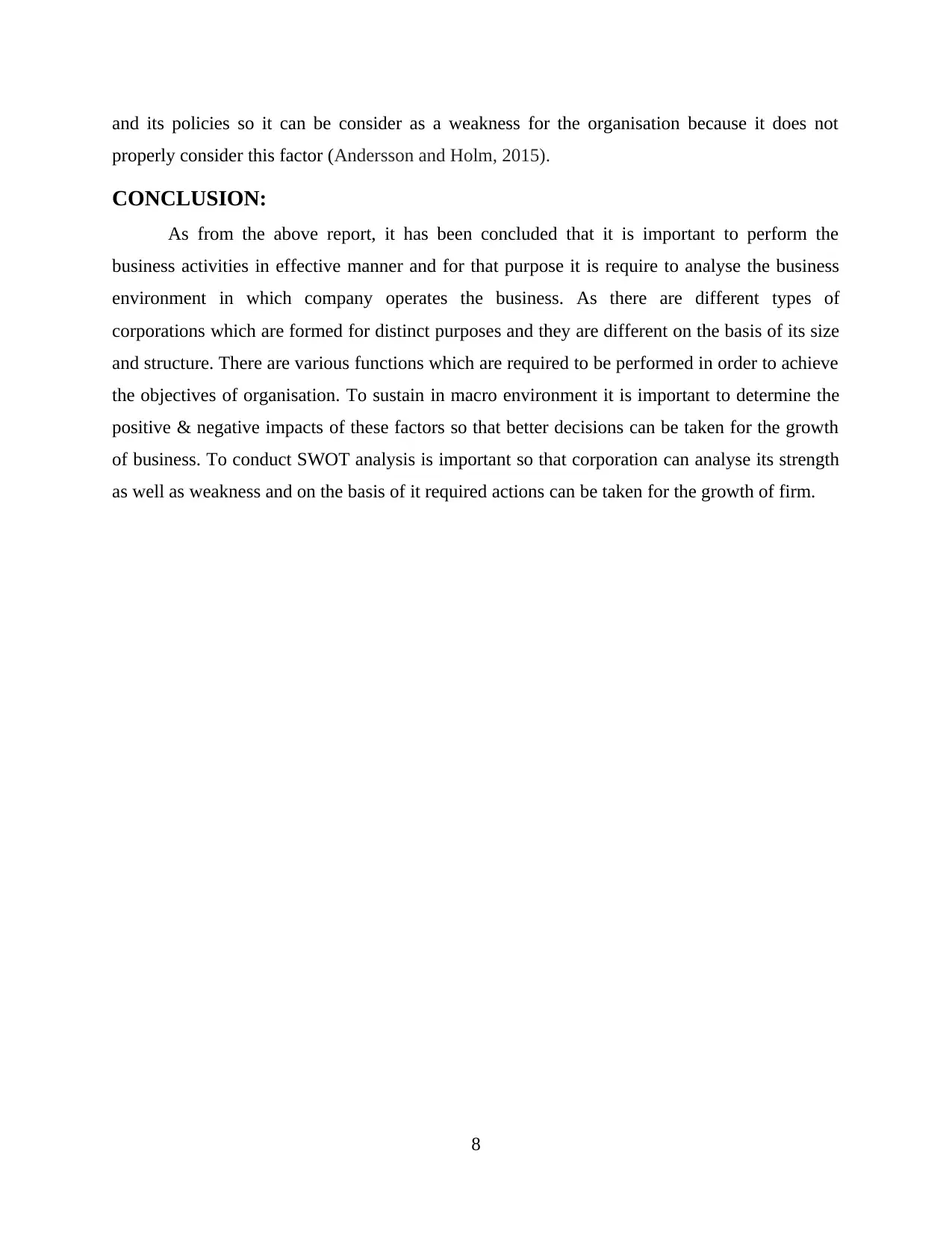
and its policies so it can be consider as a weakness for the organisation because it does not
properly consider this factor (Andersson and Holm, 2015).
CONCLUSION:
As from the above report, it has been concluded that it is important to perform the
business activities in effective manner and for that purpose it is require to analyse the business
environment in which company operates the business. As there are different types of
corporations which are formed for distinct purposes and they are different on the basis of its size
and structure. There are various functions which are required to be performed in order to achieve
the objectives of organisation. To sustain in macro environment it is important to determine the
positive & negative impacts of these factors so that better decisions can be taken for the growth
of business. To conduct SWOT analysis is important so that corporation can analyse its strength
as well as weakness and on the basis of it required actions can be taken for the growth of firm.
8
properly consider this factor (Andersson and Holm, 2015).
CONCLUSION:
As from the above report, it has been concluded that it is important to perform the
business activities in effective manner and for that purpose it is require to analyse the business
environment in which company operates the business. As there are different types of
corporations which are formed for distinct purposes and they are different on the basis of its size
and structure. There are various functions which are required to be performed in order to achieve
the objectives of organisation. To sustain in macro environment it is important to determine the
positive & negative impacts of these factors so that better decisions can be taken for the growth
of business. To conduct SWOT analysis is important so that corporation can analyse its strength
as well as weakness and on the basis of it required actions can be taken for the growth of firm.
8
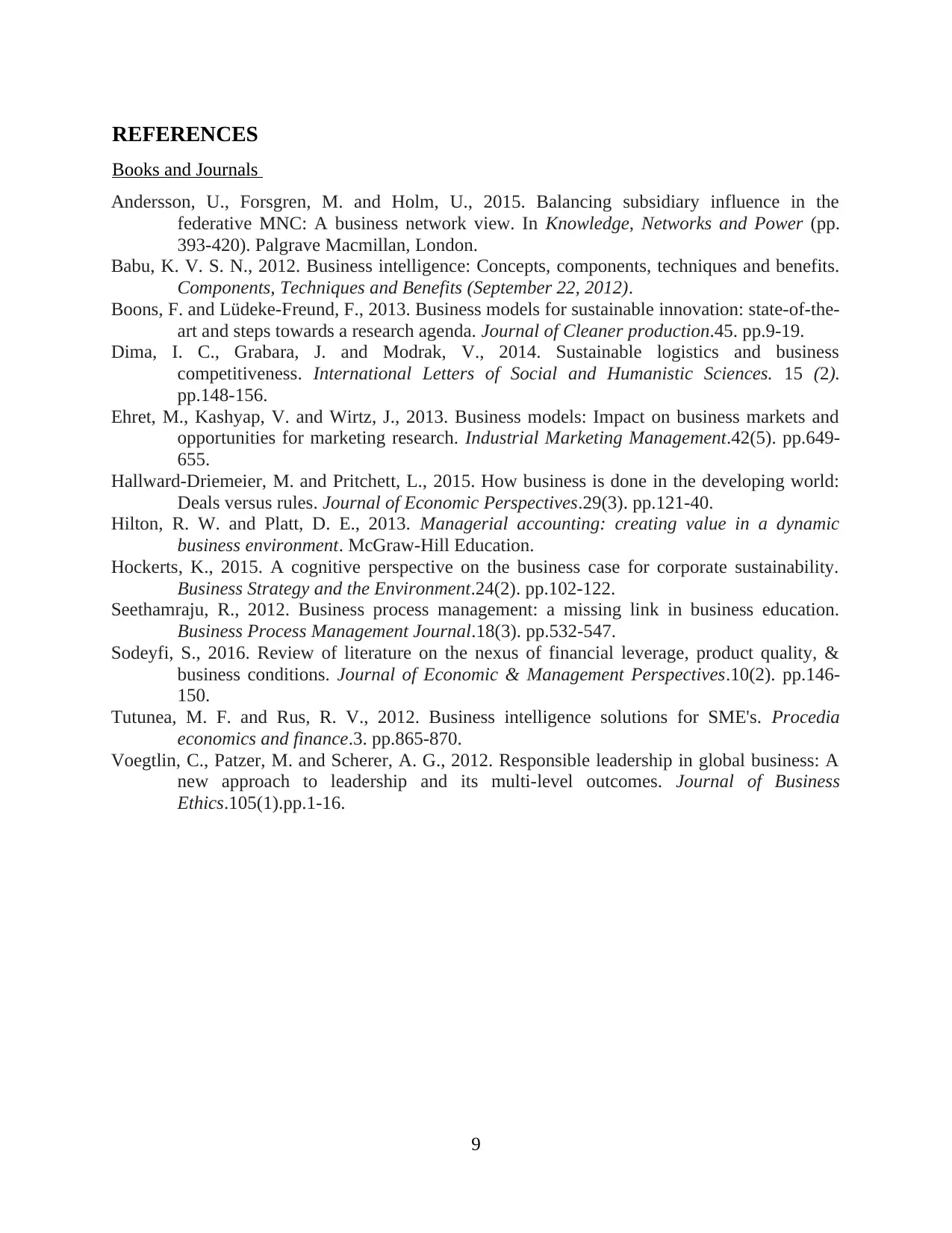
REFERENCES
Books and Journals
Andersson, U., Forsgren, M. and Holm, U., 2015. Balancing subsidiary influence in the
federative MNC: A business network view. In Knowledge, Networks and Power (pp.
393-420). Palgrave Macmillan, London.
Babu, K. V. S. N., 2012. Business intelligence: Concepts, components, techniques and benefits.
Components, Techniques and Benefits (September 22, 2012).
Boons, F. and Lüdeke-Freund, F., 2013. Business models for sustainable innovation: state-of-the-
art and steps towards a research agenda. Journal of Cleaner production.45. pp.9-19.
Dima, I. C., Grabara, J. and Modrak, V., 2014. Sustainable logistics and business
competitiveness. International Letters of Social and Humanistic Sciences. 15 (2).
pp.148-156.
Ehret, M., Kashyap, V. and Wirtz, J., 2013. Business models: Impact on business markets and
opportunities for marketing research. Industrial Marketing Management.42(5). pp.649-
655.
Hallward-Driemeier, M. and Pritchett, L., 2015. How business is done in the developing world:
Deals versus rules. Journal of Economic Perspectives.29(3). pp.121-40.
Hilton, R. W. and Platt, D. E., 2013. Managerial accounting: creating value in a dynamic
business environment. McGraw-Hill Education.
Hockerts, K., 2015. A cognitive perspective on the business case for corporate sustainability.
Business Strategy and the Environment.24(2). pp.102-122.
Seethamraju, R., 2012. Business process management: a missing link in business education.
Business Process Management Journal.18(3). pp.532-547.
Sodeyfi, S., 2016. Review of literature on the nexus of financial leverage, product quality, &
business conditions. Journal of Economic & Management Perspectives.10(2). pp.146-
150.
Tutunea, M. F. and Rus, R. V., 2012. Business intelligence solutions for SME's. Procedia
economics and finance.3. pp.865-870.
Voegtlin, C., Patzer, M. and Scherer, A. G., 2012. Responsible leadership in global business: A
new approach to leadership and its multi-level outcomes. Journal of Business
Ethics.105(1).pp.1-16.
9
Books and Journals
Andersson, U., Forsgren, M. and Holm, U., 2015. Balancing subsidiary influence in the
federative MNC: A business network view. In Knowledge, Networks and Power (pp.
393-420). Palgrave Macmillan, London.
Babu, K. V. S. N., 2012. Business intelligence: Concepts, components, techniques and benefits.
Components, Techniques and Benefits (September 22, 2012).
Boons, F. and Lüdeke-Freund, F., 2013. Business models for sustainable innovation: state-of-the-
art and steps towards a research agenda. Journal of Cleaner production.45. pp.9-19.
Dima, I. C., Grabara, J. and Modrak, V., 2014. Sustainable logistics and business
competitiveness. International Letters of Social and Humanistic Sciences. 15 (2).
pp.148-156.
Ehret, M., Kashyap, V. and Wirtz, J., 2013. Business models: Impact on business markets and
opportunities for marketing research. Industrial Marketing Management.42(5). pp.649-
655.
Hallward-Driemeier, M. and Pritchett, L., 2015. How business is done in the developing world:
Deals versus rules. Journal of Economic Perspectives.29(3). pp.121-40.
Hilton, R. W. and Platt, D. E., 2013. Managerial accounting: creating value in a dynamic
business environment. McGraw-Hill Education.
Hockerts, K., 2015. A cognitive perspective on the business case for corporate sustainability.
Business Strategy and the Environment.24(2). pp.102-122.
Seethamraju, R., 2012. Business process management: a missing link in business education.
Business Process Management Journal.18(3). pp.532-547.
Sodeyfi, S., 2016. Review of literature on the nexus of financial leverage, product quality, &
business conditions. Journal of Economic & Management Perspectives.10(2). pp.146-
150.
Tutunea, M. F. and Rus, R. V., 2012. Business intelligence solutions for SME's. Procedia
economics and finance.3. pp.865-870.
Voegtlin, C., Patzer, M. and Scherer, A. G., 2012. Responsible leadership in global business: A
new approach to leadership and its multi-level outcomes. Journal of Business
Ethics.105(1).pp.1-16.
9
⊘ This is a preview!⊘
Do you want full access?
Subscribe today to unlock all pages.

Trusted by 1+ million students worldwide
1 out of 12
Related Documents
Your All-in-One AI-Powered Toolkit for Academic Success.
+13062052269
info@desklib.com
Available 24*7 on WhatsApp / Email
![[object Object]](/_next/static/media/star-bottom.7253800d.svg)
Unlock your academic potential
Copyright © 2020–2025 A2Z Services. All Rights Reserved. Developed and managed by ZUCOL.





